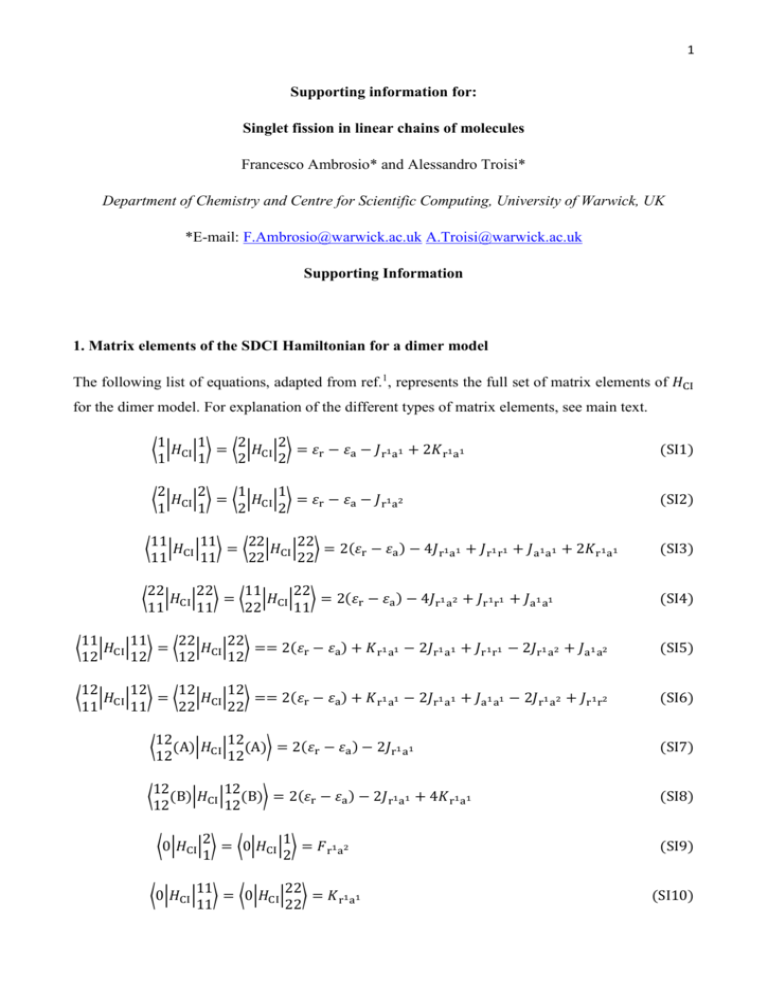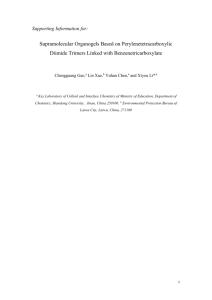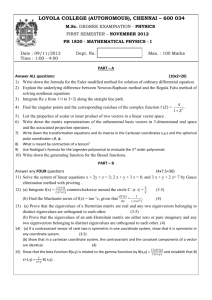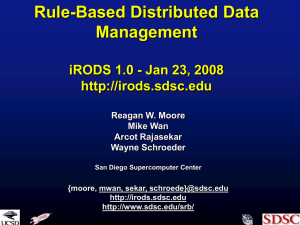Revised_Ambrosio_Troisi_Supporting_Info
advertisement

1 Supporting information for: Singlet fission in linear chains of molecules Francesco Ambrosio* and Alessandro Troisi* Department of Chemistry and Centre for Scientific Computing, University of Warwick, UK *E-mail: F.Ambrosio@warwick.ac.uk A.Troisi@warwick.ac.uk Supporting Information 1. Matrix elements of the SDCI Hamiltonian for a dimer model The following list of equations, adapted from ref.1, represents the full set of matrix elements of 𝐻CI for the dimer model. For explanation of the different types of matrix elements, see main text. 1 1 2 2 ⟨ |𝐻CI | ⟩ = ⟨ |𝐻CI | ⟩ = 𝜀r − 𝜀a − 𝐽r1 a1 + 2𝐾r1 a1 1 1 2 2 (SI1) 2 2 1 1 ⟨ |𝐻CI | ⟩ = ⟨ |𝐻CI | ⟩ = 𝜀r − 𝜀a − 𝐽r1 a2 1 1 2 2 (SI2) 11 11 22 22 |𝐻CI | ⟩ = ⟨ |𝐻CI | ⟩ = 2(𝜀r − 𝜀a ) − 4𝐽r1 a1 + 𝐽r1 r1 + 𝐽a1 a1 + 2𝐾r1 a1 11 11 22 22 (SI3) 22 22 11 22 |𝐻 | ⟩ = ⟨ |𝐻CI | ⟩ = 2(𝜀r − 𝜀a ) − 4𝐽r1 a2 + 𝐽r1 r1 + 𝐽a1 a1 11 CI 11 22 11 (SI4) ⟨ ⟨ ⟨ 11 11 22 22 |𝐻CI | ⟩ = ⟨ |𝐻CI | ⟩ == 2(𝜀r − 𝜀a ) + 𝐾r1 a1 − 2𝐽r1 a1 + 𝐽r1 r1 − 2𝐽r1 a2 + 𝐽a1 a2 12 12 12 12 (SI5) ⟨ 12 12 12 12 |𝐻 | ⟩ = ⟨ |𝐻CI | ⟩ == 2(𝜀r − 𝜀a ) + 𝐾r1 a1 − 2𝐽r1 a1 + 𝐽a1 a1 − 2𝐽r1 a2 + 𝐽r1 r2 11 CI 11 22 22 (SI6) 12 12 (A)|𝐻CI | (A)⟩ = 2(𝜀r − 𝜀a ) − 2𝐽r1 a1 12 12 (SI7) 12 12 (B)|𝐻CI | (B)⟩ = 2(𝜀r − 𝜀a ) − 2𝐽r1 a1 + 4𝐾r1 a1 12 12 (SI8) 2 1 ⟨0|𝐻CI | ⟩ = ⟨0|𝐻CI | ⟩ = 𝐹r1 a2 1 2 (SI9) 11 22 ⟨0|𝐻CI | ⟩ = ⟨0|𝐻CI | ⟩ = 𝐾r1 a1 11 22 (SI10) ⟨ ⟨ 2 12 ⟨0|𝐻CI | (B)⟩ = −√3(r1 a1 |r 2 a2 ) 12 (SI11) 1 2 ⟨ |𝐻CI | ⟩ = 2(r1 a1 |r 2 a2 ) 1 2 (SI12) 1 2 2 1 ⟨ |𝐻CI | ⟩ = ⟨ |𝐻CI | ⟩ = 𝐹r1 r2 1 1 2 2 (SI13) 1 1 2 2 ⟨ |𝐻CI | ⟩ = ⟨ |𝐻CI | ⟩ = −𝐹a1 a2 1 2 2 1 (SI14) 1 11 2 22 ⟨ |𝐻CI | ⟩ = ⟨ |𝐻CI | ⟩ = −𝐹r1 a2 1 12 2 12 (SI15) 1 12 2 12 ⟨ |𝐻CI | ⟩ = ⟨ |𝐻CI | ⟩ = 𝐹r1 a2 1 11 2 22 (SI16) 2 22 1 11 ⟨ |𝐻CI | ⟩ = ⟨ |𝐻CI | ⟩ = √2𝐹r1 a2 1 11 2 22 (SI17) 2 12 1 12 ⟨ |𝐻CI | (A)⟩ = ⟨ |𝐻CI | (A)⟩ = −√3/2𝐹r1 a2 1 12 2 12 ( SI18) 11 11 22 22 |𝐻 | ⟩ = ⟨ |𝐻CI | ⟩ = √2𝐹a1 a2 11 CI 12 22 12 (SI19) 11 12 22 12 ⟨ |𝐻CI | ⟩ = ⟨ |𝐻CI | ⟩ = √2𝐹r1 r2 11 11 22 22 (SI20) 12 22 12 12 |𝐻 | ⟩ = ⟨ |𝐻CI | ⟩ = −(r1 a1 |r 2 a2 ) 11 CI 12 22 11 (SI21) 11 12 22 12 |𝐻CI | (A)⟩ = ⟨ |𝐻CI | (A)⟩ = √2𝐹a1 a2 12 12 12 12 (SI22) 12 12 12 12 |𝐻 | (A)⟩ = ⟨ |𝐻CI | (A)⟩ = √2𝐹r1 r2 11 CI 12 22 12 (SI23) ⟨ ⟨ ⟨ ⟨ 2. Matrix elements of the SDCI Hamiltonian for a trimer model The following list of equations describes the additional types of relevant matrix elements that have to be considered in a trimer model, in addition to the types of matrix elements, considered in a 𝑖𝑗 dimer model (here we only refer to A-type | ⟩ configurations): 𝑖𝑗 ⟨ 13 12 |𝐻CI | ⟩ = −(a2 a3 |r 2 r 3 ) 13 12 (SI24) 3 13 23 |𝐻 | ⟩ = −(a1 a2 |r1 r 2 ) 13 CI 23 (SI25) 23 12 |𝐻CI | ⟩ = −(a1 a3 |r1 r 3 )~0 23 12 (SI26) ⟨ ⟨ where (a1 a3 |r1 r 3 )~0, since the matrix element is overlap dependent and, therefore, it will decay exponentially outside the overlap region, as in the case where are involved non-adjacent sites. 𝑖𝑗 The indirect coupling between | ⟩ configurations is mediated by ME-type CT configurations (we 𝑖𝑗 are always considering A-type configurations): ⟨ 23 23 13 13 |𝐻 | ⟩ = ⟨ |𝐻CI | ⟩ = −𝐹a1 a2 13 CI 23 23 13 (SI27) ⟨ 12 13 13 12 |𝐻CI | ⟩ = ⟨ |𝐻CI | ⟩ = −𝐹a2 a3 13 13 12 12 (SI28) 23 13 13 23 |𝐻 | ⟩ = ⟨ |𝐻CI | ⟩ = 𝐹r1 r2 13 CI 13 23 23 (SI29) 13 13 13 12 |𝐻CI | ⟩ = ⟨ |𝐻CI | ⟩ = 𝐹r2 r3 13 12 12 12 (SI30) ⟨ 23 12 23 12 |𝐻 | ⟩ = ⟨ |𝐻CI | ⟩ = −𝐹a1 a3 ~0 23 12 CI 23 12 (SI31) ⟨ 12 23 23 12 |𝐻CI | ⟩ = ⟨ |𝐻CI | ⟩ = −𝐹a1 a3 ~0 23 23 12 12 (SI32) ⟨ ⟨ Again, 𝐹a1 a3 ~0, because of the short-range nature of the overlap dependent matrix element. 𝑖 Finally, | ⟩ configurations couple with ME-CT configurations: 𝑖 1 13 ⟨ |𝐻CI | ⟩ = −𝐹a2 r3 1 12 (SI33) 12 1 ⟨ |𝐻CI | ⟩ = −𝐹a3 r2 13 1 (SI34) 3 13 ⟨ |𝐻CI | ⟩ = −𝐹a2 r1 3 23 (SI35) 3 23 ⟨ |𝐻CI | ⟩ = −𝐹a1 r2 3 13 (SI36) 4 21 2 ⟨ |𝐻CI | ⟩ = −𝐹a3 r1 ~0 23 2 (SI37) 2 23 ⟨ |𝐻CI | ⟩ = −𝐹a1 r3 ~0 2 21 (SI38) 3. On the effect of the relative sign of different 𝑭′ elements on the eingevalues The change in the eigenvalues, due to different relative signs of 𝐹r1 a2 , 𝐹r1 r2 ,𝐹a1 a2 in a dimer P-like system (𝐹r1 a2 and 𝐹a1 r2 are set to be equal), is evaluated. The lowest eigenvalues for different choices of the relative signs of the Fock elements are collected in Table SI1, showing that the differences are fairly modest and depend only on the relative sign of 𝐹r1 r2 and 𝐹a1 a2 . Table SI1: Lowest eigenvalues (eV) for a dimer P-like system for different relative signs of the 𝑭′ elements. 𝐹a1 a2 = +0.15 eV 𝐹a1 a2 = +0.15 eV 𝐹a1 a2 = +0.15 eV 𝐹a1 a2 = −0.15 eV 𝐹r1 r2 = +0.15 eV 𝐹r1 r2 = −0.15 eV 𝐹r1 r2 = +0.15 eV 𝐹r1 r2 = +0.15 eV 𝐹r1 a2 = +0.15 eV 𝐹r1 a2 = +0.15 eV 𝐹r1 a2 = −0.15 eV 𝐹t1 a2 = +0.15 eV 1 −0.34125 −0.34126 −0.34125 −0.34126 2 1.66507 1.66831 1.66507 1.66831 3 1.95438 1.99687 1.95438 1.99687 4 2.59596 2.53469 2.59596 2.53469 5 3.14609 3.14246 3.14609 3.14246 6 3.34761 3.36019 3.34761 3.36019 Eigenvalue ̅ 𝒔 −𝐌𝐄 and 𝒌𝐌𝐄 4. On the effect of the relative sign of different 𝑭′ elements on 𝑽 𝟏 𝟏𝟐 𝟏𝟐 The change in 𝑉̅𝑠1 −ME12 , due to different relative signs of 𝐹ri aj , 𝐹ri rj ,𝐹ai aj in a trimer P-like system along with the correspondent change in 𝑘ME12 is evaluated. The results for different choices of the relative signs of the Fock elements are collected in Table SI2. When the signs of 𝐹r1 r2 and 𝐹a1 a2 . are opposite the computed rate decreases by one order of magnitude as a result of negative interference between different coupling paths. 5 ̅𝐬 −𝐌𝐄 (eV) and 𝐋𝐨𝐠(𝐤 𝐌𝐄 /𝐬 −𝟏 ) for a trimer P-like system for different relative signs of the 𝑭′ elements. Table SI2: 𝐕 𝟏 𝟏𝟐 𝟏𝟐 𝐹ai aj = +0.15 eV 𝐹ai aj = +0.15 eV 𝐹ai aj = +0.15 eV 𝐹ai aj = −0.15 eV 𝐹ri rj = +0.15 eV 𝐹ri rj = −0.15 eV 𝐹ri rj = +0.15 eV 𝐹ri rj = +0.15 eV 𝐹ri aj = +0.15 eV 𝐹ri aj = +0.15 eV 𝐹ri aj = −0.15 eV 𝐹ri aj = +0.15 eV ̅ 𝒔 −𝐌𝐄 𝑽 𝟏 𝟏𝟐 −0.019467 0.005970 −0.019467 0.005970 𝐋𝐨𝐠(𝒌𝐌𝐄𝟏𝟐 ) 13.151 12.123 13.151 12.123 5. Analysis of the accuracy of the matrix partitioning scheme The eigenvalues of the states of interest (S and ME states) for a linear tetramer (P-like parameters) obtained from a full SDCI Hamiltonian are compared with the ones obtained with the matrix partitioning approach, in order to test the accuracy of our approach. The results are collected in Table SI3. Table SI3: Eigenvalues (eV) of the states of interest for 𝑁 = 4, 𝑉𝑒𝑥 = 0.10 eV, 𝐹 ′ = 0.15 eV, computed from a full SDCI Hamiltonian (column a) and with the matrix partitioning scheme (column b). State a b S1 1.9142 1.9171 S2 2.1086 2.1094 S3 2.3702 2.3805 S4 2.6322 2.6363 MEb1 1.6447 1.6450 MEb2 1.6452 1.6557 MEb3 1.6457 1.6559 MEu1 1.7168 1.7053 MEu2 1.7170 1.7121 MEu3 1.7421 1.7377 6. Reorganization energies and Huang-Rhys factors for the ME←S1 transition Reorganization energy for the T1←S0 transition has been computed at the B3LYP/6-31G* level of theory for a tetracene and pentacene molecule, as the difference between the energy of the optimized electronic structure of T1 (𝐸(T1 )T1 ) and the energy of T1 in the optimized geometry of S0 (𝐸(T1 )S0 ) following the procedure adopted in ref.2, 3 6 𝜆T1 ←S0 = 𝐸(T1 )T1 − 𝐸(T1 )S0 (SI39) Therefore, 𝜆ME←S1 for a transition taking place in a linear chain of molecules will be twice the value of 𝜆T1 ←S0 . We are considering that the geometry of S1 is identical to the one of S0, because of delocalization of the S1 state over several molecules, and that the ME state geometry is assumed to be the equilibrium geometry of two triplet states, because of localization of this type of state. Computed value of 𝜆T1 ←S0 is 0.217 eV for pentacene and 0.257 eV for tetracene, respectively, which gives values of 𝜆ME←S1 equal to 0.434 eV for pentacene and 0.514 eV for tetracene, respectively. 7. Dependence of the rate from the value of 𝑭′ We compute the rate as a function of 𝐹′ matrix element (we consider 𝐹ri aj = 𝐹ri rj = 𝐹ai aj ) in a trimer model. In particular, we compute the rate of the transition from the S1 state to one of the two MEb states of the trimer (ME12), and to the MEu state (ME13) The rate is computed at 𝜎min , for a fixed value of Δ𝐸 (0.2 eV). Results are reported in Figure SI1: Figure SI1: Log(𝑘) as a function of 𝐹′, computed at 𝜎min , for 𝑁 = 3. Black dotted line shows an appropriately scaled (𝐹 ′ )4 function. 7 The graph shows that the SF rate is roughly proportional to the fourth power of 𝐹′ (𝑉̅𝑠1 −ME depends on the square of the 𝐹′, and it is squared in the FGR equation). We also pinpoint that this contains only the effect of the 𝐹′ element on the coupling, as 𝐹′ matrix elements also modulate the difference Δ𝐸 between MEb and MEu states, which decreases as 𝐹′ decreases. References 1. A. Gamba, G.F. Tantardini and M. Simonetta, Spectrochim. Acta Mol. Spectros. 28A, 1877 (1972). 2. N. E. Gruhn, D. A. da Silva Filho, T. G. Bill, M. Malagoli, V. Coropceanu, A. Kahn and J.L. Brédas, J. Am. Chem. Soc. 124, 7918 (2002). 3. G. D. Scholes and K. P. Ghiggino, J. Chem. Phys. 101, 1251 (1994).










